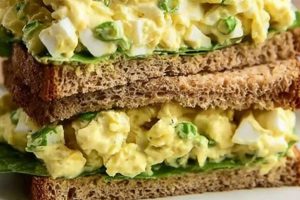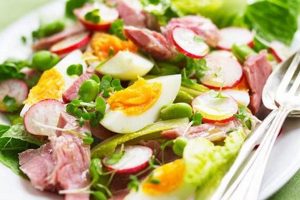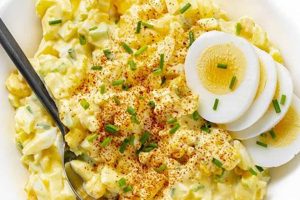A dish comprised of chopped cooked turkey, hard-boiled eggs, and often other ingredients such as celery, onion, mayonnaise, and seasonings, this culinary creation provides a versatile and protein-rich meal. Variations can include grapes, nuts, cranberries, or different herbs and spices to suit individual preferences. It can be enjoyed as a sandwich filling, a light lunch, or served on lettuce cups or crackers.
This readily customizable dish offers a nutritious and satisfying option, ideal for using leftover turkey. Its adaptable nature allows for creative ingredient combinations, catering to diverse palates and dietary needs. Historically, similar combinations of meat and bound salads have been enjoyed for centuries, evolving alongside refrigeration and readily available ingredients. Its simplicity and ease of preparation contribute to its enduring popularity.
Further exploration will cover variations on this classic dish, including ingredient selection, preparation techniques, and serving suggestions to enhance the culinary experience.
Tips for an Exceptional Turkey Salad with Egg
Elevating this classic dish requires attention to detail and an understanding of how individual components contribute to the final product. The following tips offer guidance for creating a superior culinary experience.
Tip 1: Moisture Control: Excess moisture can dilute flavor and create an unappetizing texture. Thoroughly dry all ingredients, particularly the turkey and vegetables, after chopping. Consider salting the diced vegetables and allowing them to rest in a colander to draw out excess moisture before incorporating them into the salad.
Tip 2: Turkey Selection: While leftover roasted turkey is a common choice, other turkey preparations, such as smoked or grilled turkey, can offer unique flavor profiles. Ensure the turkey is cooled completely before chopping to prevent the mayonnaise from separating.
Tip 3: Egg Perfection: Properly cooked hard-boiled eggs are essential. Overcooked yolks can develop a greenish tinge and a dry texture. Aim for a firm, yet creamy yolk by cooking the eggs for the appropriate time and immediately plunging them into ice water to stop the cooking process.
Tip 4: Mayonnaise Matters: The quality and type of mayonnaise significantly impact the final flavor. Experiment with different varieties, such as olive oil mayonnaise or flavored mayonnaise, to complement the other ingredients. Start with a smaller amount of mayonnaise and add more as needed to achieve the desired consistency.
Tip 5: Seasoning Strategies: Freshly ground black pepper, salt, and a touch of Dijon mustard are classic additions. Consider incorporating herbs such as dill, tarragon, or chives for an enhanced flavor profile. Taste and adjust seasonings throughout the preparation process.
Tip 6: Textural Variety: A combination of textures creates a more engaging eating experience. Incorporate chopped celery, red onion, or water chestnuts for a satisfying crunch. Toasted nuts or seeds can also add a pleasant textural element.
Tip 7: Chilling Time: Allowing the salad to chill for at least 30 minutes before serving allows the flavors to meld and develop. This also firms the texture, making it ideal for sandwiches or wraps.
By following these guidelines, one can create a turkey salad with egg that transcends the ordinary and delivers a truly exceptional dining experience. These insights provide the foundation for culinary creativity and personalized flavor combinations.
In conclusion, careful ingredient selection, precise preparation, and attention to detail contribute to a remarkable outcome. Experimentation and customization are encouraged to tailor the final product to individual preferences.
1. Ingredients
Ingredient selection significantly impacts the final character of a turkey salad with egg. Each component contributes not only to flavor but also to texture, moisture content, and overall nutritional value. Consider the interplay between core ingredients and supplemental additions. Turkey, the primary protein source, can vary in flavor profile depending on its origin (roasted, smoked, etc.). Eggs provide richness and binding properties, while mayonnaise contributes creaminess and tang. The choice of vegetables, such as celery, onion, or bell pepper, introduces textural contrast and distinct flavors. Seasonings, including salt, pepper, herbs, and spices, further enhance the complexity of the dish. For instance, using roasted turkey lends a savory depth, while smoked turkey imparts a richer, more intense flavor. The addition of fresh herbs like dill or chives can brighten the overall palate, while spices such as paprika or curry powder introduce warmth and complexity.
The quality and freshness of ingredients directly correlate with the final product’s appeal. Freshly roasted turkey offers superior flavor compared to pre-packaged deli turkey. Farm-fresh eggs contribute a richer, creamier yolk than older eggs. Homemade mayonnaise, crafted with high-quality oils and fresh lemon juice, surpasses commercially produced versions in flavor and texture. Opting for seasonal vegetables ensures peak flavor and optimal crispness. Understanding these nuances allows for informed decisions that elevate the overall dining experience. An example would be substituting Greek yogurt for a portion of the mayonnaise to reduce fat content while maintaining creaminess and adding a tangy note.
Strategic ingredient combinations create a balanced and harmonious flavor profile. The richness of the turkey and eggs benefits from the addition of acidic elements, such as lemon juice or vinegar, to cut through the fat and brighten the palate. The creaminess of mayonnaise is complemented by the crispness of celery and the sharpness of red onion. A careful balance of herbs and spices further enhances complexity without overpowering the other flavors. Ultimately, thoughtful ingredient selection and preparation elevates this simple dish into a culinary delight. Challenges may include sourcing high-quality ingredients and balancing flavors effectively, but the resulting satisfaction warrants the effort. This careful consideration of ingredients forms the cornerstone of a successful turkey salad with egg recipe, laying the foundation for a flavorful and enjoyable culinary experience.
2. Preparation
Preparation methods significantly influence the final quality and enjoyment of a turkey salad with egg recipe. Careful execution of each step, from ingredient handling to combining components, ensures optimal flavor development, texture, and food safety. This section explores key facets of preparation that contribute to a successful outcome.
- Ingredient Handling
Proper handling ensures both food safety and optimal flavor. Thorough washing of vegetables removes potential contaminants and pesticides. Safe handling of poultry and eggs minimizes the risk of bacterial contamination. Chilling ingredients before combining helps maintain a desirable temperature and prevents mayonnaise from separating. For example, washing lettuce and then drying it thoroughly prevents a watery salad, while ensuring turkey reaches a safe internal temperature before chopping safeguards against foodborne illness. Proper handling forms the foundation for a safe and flavorful dish.
- Chopping and Dicing
Uniformity in chopping and dicing contributes to both aesthetic appeal and even flavor distribution. Consistently sized pieces ensure that all ingredients incorporate evenly throughout the salad, preventing pockets of individual flavors. This also contributes to a pleasant mouthfeel. For example, finely dicing celery and onions allows their flavors to meld seamlessly with the other ingredients, while coarsely chopped turkey provides a more substantial texture. The choice of cutting technique directly influences the final presentation and eating experience.
- Combining Ingredients
The order and manner in which ingredients are combined impacts the final texture and flavor. Adding mayonnaise gradually prevents over-saturation and allows for adjustment of consistency. Gentle folding preserves the integrity of delicate ingredients and prevents the salad from becoming overly dense. For example, incorporating dry ingredients first, followed by the wet ingredients, ensures even distribution and prevents clumping. A light touch prevents crushing delicate components like grapes or herbs.
- Chilling and Resting
Allowing the salad to chill before serving enhances flavor development and allows the ingredients to meld. Chilling also firms the texture, making the salad easier to handle for sandwich fillings or other presentations. Resting time allows the flavors to marry and deepen. For instance, chilling for at least 30 minutes allows the flavors of the herbs and spices to permeate the salad, creating a more complex flavor profile. This step enhances overall enjoyment and allows for better portioning.
These preparatory steps, when executed with care and precision, contribute significantly to the overall success of the turkey salad with egg recipe. From ingredient handling to chilling and resting, each stage plays a crucial role in creating a flavorful, safe, and aesthetically pleasing dish. Understanding these nuances empowers culinary creativity and elevates the final product from simple to exceptional.
3. Flavor Balance
Flavor balance constitutes a critical element in a successful turkey salad with egg recipe. This balance hinges on the interplay of savory, acidic, creamy, and textural components, creating a harmonious and palatable experience. The richness of the turkey and eggs necessitates a counterpoint; acidic elements like lemon juice or vinegar cut through the fat, brightening the overall profile. Creaminess, typically imparted by mayonnaise, benefits from the textural contrast of crisp vegetables such as celery or red onion. Consider the interplay of salt and pepper, enhancing the inherent savory notes of the turkey while providing foundational seasoning. Aromatic additions, like fresh herbs or spices, introduce complexity and depth without overwhelming the core flavors. An example of successful flavor balance involves using a Dijon mustard vinaigrette instead of plain mayonnaise, adding both acidity and complexity.
Achieving optimal flavor balance requires careful consideration of ingredient ratios and complementary flavor pairings. Too much mayonnaise can overpower the other components, leading to a cloying richness. Insufficient acidity can result in a bland and uninspired salad. Over-reliance on strong aromatics, such as garlic or onion, can mask the delicate flavors of the turkey and eggs. Understanding these potential pitfalls allows for proactive adjustments during preparation. For instance, if using a particularly savory turkey, one might increase the amount of acid to maintain balance. If incorporating a strong cheese, like blue cheese, a lighter hand with other seasonings may be warranted. Practical application involves tasting and adjusting throughout the process, ensuring a harmonious final product.
Flavor balance elevates the turkey salad with egg recipe from a simple combination of ingredients to a nuanced and satisfying culinary experience. This principle allows for endless variations and personalized adjustments, catering to individual preferences. Challenges lie in recognizing and correcting imbalances, but the resulting depth of flavor justifies the effort. The practical significance of understanding flavor balance lies in the ability to create a dish that is not only palatable but also memorable. It exemplifies the culinary principle that the whole is greater than the sum of its parts.
4. Texture
Texture plays a crucial role in the overall enjoyment of a turkey salad with egg recipe. A successful rendition offers a pleasing interplay of contrasting textures, creating a multi-dimensional sensory experience. The inherent softness of the turkey and egg necessitates the incorporation of contrasting textural elements. Crisp vegetables, such as celery, red onion, or water chestnuts, provide a satisfying crunch. Nuts, like chopped pecans or walnuts, introduce a pleasant chewiness. Even the texture of the mayonnaise contributes to the overall mouthfeel, ranging from light and fluffy to dense and creamy. These varied textures prevent monotony and elevate the dish beyond a simple combination of ingredients. Consider the difference between a salad composed solely of soft ingredients and one that incorporates crunchy elements; the latter offers a more engaging and satisfying culinary experience. For example, the addition of toasted slivered almonds introduces both a textural and flavor contrast to the creamy base of the salad.
Manipulating texture within the recipe allows for customized results. Finely dicing vegetables results in a smoother, more integrated texture, while coarser chopping creates more pronounced textural contrast. The choice of turkey preparation also impacts texture; shredded turkey offers a finer texture than cubed or chopped turkey. These seemingly small variations significantly affect the overall eating experience. Practical applications include adjusting the chopping size of vegetables based on personal preference or using a combination of textures, such as toasted breadcrumbs and chopped walnuts, to create a more complex textural profile. Understanding these nuances allows for intentional textural manipulation, enhancing the overall appeal of the dish.
Mastering the element of texture in a turkey salad with egg recipe demonstrates an understanding of culinary principles beyond basic flavor combinations. It showcases an awareness of the interplay between different sensory elements and their combined impact on the overall dining experience. Challenges may include balancing contrasting textures without creating an overwhelming or disjointed mouthfeel, but the resulting textural depth significantly elevates the final product. The practical significance of understanding texture lies in the ability to create a dish that is not only flavorful but also offers a satisfying and engaging textural experience.
5. Presentation
Presentation significantly impacts the perceived value and enjoyment of a turkey salad with egg recipe. While flavor and texture remain paramount, visual appeal enhances the overall dining experience. Thoughtful presentation elevates this simple dish from a casual meal to a more refined culinary offering. The choice of serving vessel, the arrangement of the salad, and the accompanying garnishes contribute to the final presentation. Serving the salad on a bed of crisp lettuce within a hollowed-out tomato transforms a simple scoop of salad into an elegant appetizer. Garnishing with fresh herbs, a sprinkle of paprika, or a scattering of toasted nuts adds visual interest and hints at the underlying flavors. These seemingly small details significantly influence the perceived quality and enjoyment of the dish. Consider the difference between a mound of salad served on a plain plate versus a carefully arranged portion served on a bed of greens with thoughtfully chosen garnishes; the latter immediately conveys a greater sense of care and attention to detail.
Practical applications of presentation principles vary depending on the context. For a casual lunch, a simple sandwich or wrap presentation suffices. For a more formal setting, arranging the salad on individual plates with carefully chosen accompaniments elevates the presentation. Using cookie cutters to shape the salad adds a touch of whimsy for festive occasions. Serving the salad in endive spears or small pastry shells transforms it into elegant finger food. These varied approaches demonstrate the versatility of the dish and its adaptability to different occasions. For example, serving the salad as a filling for deviled eggs creates a visually appealing and thematically appropriate appetizer for a brunch or luncheon. Understanding these nuances allows for a tailored presentation that enhances the overall dining experience.
Mastering the art of presentation demonstrates an understanding of the holistic nature of culinary arts, extending beyond mere flavor and texture. It acknowledges the importance of visual appeal in enhancing the overall perception and enjoyment of a dish. Challenges may include balancing aesthetic appeal with practicality and avoiding overly elaborate presentations that detract from the food itself. However, the ability to present a dish in a visually appealing manner significantly elevates the dining experience, transforming a simple turkey salad with egg recipe into a culinary creation that delights both the palate and the eye. This attention to detail underscores the significance of presentation as a key element in the overall success of the recipe.
6. Storage
Proper storage is crucial for maintaining the quality, flavor, and safety of turkey salad with egg. This encompasses understanding optimal storage conditions, appropriate containers, and recognizing signs of spoilage. Neglecting proper storage protocols can compromise the dish, leading to undesirable textural changes, flavor degradation, and potential bacterial growth. This section outlines essential storage practices to ensure the longevity and safety of the prepared salad.
- Container Selection
Choosing appropriate storage containers plays a vital role in preserving the salad’s freshness. Airtight containers prevent oxidation and minimize exposure to airborne contaminants. Durable, food-grade materials ensure the integrity of the container and prevent leaching of chemicals into the food. The size of the container should match the quantity of salad, minimizing excess air space. For example, glass or BPA-free plastic containers with tight-fitting lids are ideal choices. Using improper containers, such as those made of reactive metals or those with loose-fitting lids, can compromise the salad’s quality and safety.
- Temperature Control
Maintaining a consistent, low temperature is essential for inhibiting bacterial growth and preserving the salad’s freshness. Refrigeration at or below 40F (4C) is crucial for slowing down microbial activity and extending shelf life. Avoid storing the salad in the “danger zone” between 40F and 140F (4C and 60C), where bacteria thrive. For example, placing the container at the back of the refrigerator, where the temperature remains most consistent, is recommended. Leaving the salad at room temperature for extended periods, especially in warm environments, increases the risk of spoilage and foodborne illness.
- Shelf Life
Understanding the shelf life of turkey salad with egg is crucial for safe consumption. Even under optimal storage conditions, the salad’s quality degrades over time. Generally, turkey salad with egg should be consumed within 3-5 days of preparation. Factors such as ingredient quality and storage temperature can influence shelf life. For example, using fresh, high-quality ingredients and maintaining consistent refrigeration can extend the salad’s palatability. Consuming the salad beyond its recommended shelf life, even if it appears visually acceptable, increases the risk of foodborne illness.
- Recognizing Spoilage
Recognizing signs of spoilage is crucial for preventing foodborne illness. Indicators of spoilage include a sour or off odor, changes in texture (slimy or mushy), discoloration, and mold growth. If any of these signs are present, the salad should be discarded immediately. Relying solely on visual inspection is insufficient; spoilage can occur without visible changes. For example, even if the salad appears normal, the presence of a sour odor indicates bacterial growth and renders the salad unsafe for consumption. Discarding questionable salad is essential for preventing illness.
Adhering to these storage guidelines ensures the safety and maximizes the enjoyment of a turkey salad with egg recipe. Proper storage preserves the intended flavors, textures, and overall quality of the dish, preventing waste and safeguarding against potential health risks. Understanding and implementing these practices demonstrates a commitment to both culinary excellence and food safety. These storage practices, while seemingly simple, represent an integral component of the overall culinary process, ensuring a safe and enjoyable dining experience.
Frequently Asked Questions
This section addresses common inquiries regarding the preparation and enjoyment of turkey salad with egg, offering practical guidance and clarifying potential uncertainties.
Question 1: How long can turkey salad with egg be safely stored in the refrigerator?
Properly stored in an airtight container at or below 40F (4C), turkey salad with egg typically remains safe for consumption for 3-5 days. However, quality degradation occurs over time. Always discard the salad if any signs of spoilage, such as off odors, discoloration, or textural changes, are present.
Question 2: What type of mayonnaise is recommended for turkey salad with egg?
While classic mayonnaise is a traditional choice, variations such as olive oil mayonnaise, avocado oil mayonnaise, or even plain Greek yogurt can offer unique flavor profiles and potentially lower fat content. The choice depends on individual preferences and dietary considerations.
Question 3: Can other ingredients be added to enhance flavor and texture?
Numerous ingredients can enhance the flavor and texture of turkey salad with egg. Chopped celery, red onion, grapes, dried cranberries, apples, walnuts, pecans, and various herbs and spices can add complexity and interest. Experimentation is encouraged to discover preferred flavor combinations.
Question 4: How can excess moisture be avoided in the salad?
Excess moisture can lead to a diluted flavor and undesirable texture. Ensure all ingredients, particularly the turkey and vegetables, are thoroughly dried before combining. Salting diced vegetables and allowing them to rest in a colander can draw out excess moisture prior to incorporation.
Question 5: Can frozen turkey be used for turkey salad?
While fresh or leftover roasted turkey is preferred for optimal flavor and texture, frozen turkey can be used. Ensure the turkey is fully thawed and patted dry before incorporating it into the salad. Overly dry or freezer-burned portions should be discarded to avoid compromising the final product.
Question 6: What are common signs that turkey salad with egg has spoiled?
Spoilage indicators include a sour or off odor, changes in texture (slimy or mushy), discoloration (greyish or greenish hues), and visible mold growth. If any of these signs are present, discard the salad immediately, regardless of its apparent visual appeal. When in doubt, err on the side of caution.
Understanding these commonly addressed questions empowers informed decision-making during preparation and storage, contributing to a safer and more enjoyable culinary experience. Careful consideration of these points enhances the overall satisfaction derived from this versatile dish.
This concludes the frequently asked questions section. The following segment will explore various serving suggestions and creative presentation ideas for turkey salad with egg.
Turkey Salad with Egg Recipe
Exploration of the turkey salad with egg recipe reveals a dish offering nuanced complexities beyond its seemingly simple composition. From ingredient selection and preparation techniques to flavor balancing, textural considerations, presentation aesthetics, and proper storage protocols, each facet contributes to the final culinary outcome. Careful attention to these elements elevates the dish from a basic combination of ingredients to a carefully crafted culinary creation. The versatility of this recipe allows for personalized adaptations, catering to individual preferences and dietary needs. Emphasis on ingredient quality, proper handling techniques, and balanced flavor profiles ensures a satisfying and safe dining experience.
Culinary exploration extends beyond mere sustenance; it delves into the art of combining flavors, textures, and presentations to create a holistic sensory experience. The turkey salad with egg recipe, while seemingly commonplace, provides a canvas for culinary expression. Mastery of this recipe demonstrates an understanding of fundamental culinary principles applicable to a wider range of gastronomic endeavors. This exploration encourages further experimentation and a deeper appreciation for the transformative potential of even the most familiar ingredients. The potential for creativity within this seemingly simple dish remains vast, inviting continued exploration and personalized interpretations.






